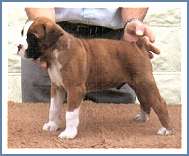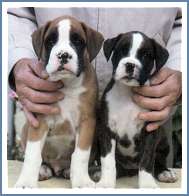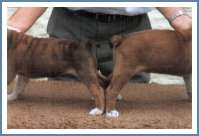Parts 1 and 2 of this article describe the attempt to introduce the bob-tail gene from a Pembroke Welsh Corgi into the Boxer. The introduction of the gene for erect ears was a further option. In the first cross all the progeny loked like rather large Corgis with ears that tended to be erect and several had bob-tails. In the backcross of two bob-tail bitches with bob-tails to a Boxer dog, a range of greatly different progeny were obtained, with long or short legs, long or short coats, bob-tail or normal, but some were very like Boxers. Here the results of a second backcross to a Boxer using a bob-tail bitch of general Boxer appearance. The bitch (Jane) was Boxer white (with a red-fawn patch), the Boxer dog was solid with very limited white markings (lacking the gene for white) and was otherwise brindle in colour.
THE RESULTS
Jane had her litter on schedule and while she she was not in the league of the previous generation which required only two hours to produce a whole litter, she did quite creditably producing her eight pups in eight hours and with relative ease. And, at birth, how did the pups conform with expectations?
|
|
-
White markings: none were white like the dam or solid like the sire; all showed the expected flashy white markings (Fig.18) unfortunately still regarded by many as essential to the show Boxer. A little surprisingly, as a litter their white markings were quite extensive, yet still fully within Boxer range.
-
Red versus brindle: two were clearly red, five were clearly brindle and one was difficult to tell. Apart from the last one, all was fine.
-
Tails: five had bob-tails (4 bitches and one dog) and the remaining three had normal Boxer tails. Two of the bob-tails were about one-quarter to one third normal length and three had short tails ideal for a docked Boxer. With a 50:50 expectation, luck was with us if one wanted a bob-tali bitch for the next generation.
-
In general appearance they all looked like Boxers.
|
Fig.18. The eight puppies from the cross of the white Boxer-like bitch of the second backcross with the solid dog lacking the gene for white. All show the standard flashy white markings of the typical Boxer show dog. A size difference is evident. |
The head type, which is a characteristic feature of the Boxer even at this early age, was highly evident in all the pups. In fact some of the heads were most promising, with short, broad muzzles and neatly domed skulls.
Over the next week or two it was no longer possible to think of them as 'Borgies'. They were scrutinised as if from a purebred Boxer litter for show quality. The only surprise was that there was a distribution of sizes at birth from the largest pup, weighing 1lb, to the smallest weighing only 9ozs (Fig. 18). There was no association of size with tail type, one of the two biggest puppies having a bob-tail and one of the two smallest having a long tail.
Over the first week, the smaller pups grew disproportionately fast and nearly caught up with their larger sibs. All seemed normal and generally almost too good to be true. But then, as this is a real-life story, things started to go wrong. Mastitis and then kennel cough hit us and the latter got to the puppies. I thought this might be the end of the study. But, perhaps because of their mixed German, Dutch and British Boxer background, plus a dose of Corgi, all but one survived. The smaller members of the litter were knocked back to most.
|
|
 |
Fig.19. A brindle bitch, aged five weeks, 7/8 Boxer, 1/8 Corgi, yet typically Boxer. Her bob-tail is the longest in the litter. |
|
Fig. 20. A red bitch, sister of the brindle in Fig.19, with the shorter bob-tail. |
At the time of writing the seven remaining puppies have reached five weeks of age and we can begin to see what we really have, good and bad. Boxer type prevails (Figs 19 & 20 above). All have long straight legs, short backs and short coats. There is nothing foreign in their build to suggest Corgi in their ancestry.
 |
|
Heads, however, betray them, but only when considered as a litter. Some have Boxer heads of a standard that at this age one would be pleased to have in any Boxer litter. Thus, two have extremely short deep heads that surely derive from the Continental Boxer background, while a third has a finer skull, yet with great muzzle development and with a really beautiful eye (Fig. 21).
Only one in fact has a longer head somewhat pointy muzzle that has some suggestion of Corgi. The heads of the remaining three puppies fall between the two extremes but, despite some inadequacy of stop, this would never identify them as other than purebred Boxers. This, at least is the view of the moment. And impressions change every day.
Beyond this, all of the puppies have the undershot jaw, which will not alter, and several have extraordinary, wide, straight mouths which are better than commonly seen in Boxer pups. Maybe this will stay. And eye size looks very good. |
Fig. 21. The larger red dog with promising head and the smaller brindle bitch with blockier Continental head. |
|
There were two surprises. The one pup of ambiguous colour at birth became of interest at two weeks of age when the blackness of its coat appeared more a mis-marking (Fig. 23) than a brindling.

|
|
It looked as though someone with sooty hands had picked it up, there being a suggestion of banding over the ribs but with the most blackness over the loin and rump. Boxers with more limited degrees of black patches have been seen in this country and abroad and, whenever tested, the condition has not bred on. The patchiness of this puppy looked different, but each day the blackness became less evident, and the puppy may finish up as a sooty red - again not unknown in Boxers.
Of more importance is the development of the bob-tails. Here, I have to express a little disappointment. While two pups have acceptable short tails like their dam, with just a dip at the end attributable to soft tissue and hair, which could be trimmed, the other two each have a definite tail kink (Fig. 23). Despite this additional feature, I think it can still be fairly claimed that one of the original objectives has just about been achieved. We now have several 'bob-tail Boxers' of potential show quality. Time will decide whether the latter is really true.
|
Fig. 23. The puppy on the left shows the sooty black markings that are disappearing rapidly. It also has the first kinked tail among the bob-tail dogs in any generation. The puppy on the right shows the more suitabler straight tail, the downwards bend at the end representing only soft tissue and hair. |
|
WHAT ABOUT ERECT EARS?
So far all attention has been given to the bob-tail characteristic and the introduction of the gene into the Boxer. This was one of the original objectives of course and the process was accelerated by the appearance of the remarkably Boxer-like Jane, with her bob-tail, in only the second generation.
We did have two other bitches with the stiff Corgi type ears, but both had the short legs and long coats.(Fig.24) Therefore, compared with Jane, breeding from them seemed a big step backwards. However, the option was there and when one came into season, actually before Jane, and the owners were desperate for the bitch to have a litter, we decided to have a try.
The first problem was the choice of stud dog. It seemed to me that that a Boxer with small 'flying' ears might be the most suitable. Ideally, of course, I would have wanted one that was solid to avoid the problem of whites. However, much screening along the benches at shows earlier this year failed to identify a single dog with the required ear type. In desperation, therefore, we simply decided to use one of our own dogs. Again, Gordon Seeney was called into help and with the aid of a platform to equalise the heights, little difficulty was encountered in obtaining a mating. However, the bitch did not get pregnant.
|
|
|
| |
Fig. 24. One of the stiff eared bitches from the second generation. Boxer markings and coat, and with bob-tail, but obviously short legged. |
It had been expected that half the puppies would inherit the erect ear gene. Hopefully, these would have been identifiable by, at minimum, a stiffness of the ears.
WHITE MARKINGS THAT BREED TRUE?
The Corgi type of white marking is essentially identical to that of the flashily marked Boxer, white flash on the face, white socks and variably a white collar. The big difference is that whereas breeding such Boxers commonly results in the production of whites, the Corgi white markings breed true. It is possible that the Corgi form of the gene used to exist in Boxers as in the early days of the breed as piebald or check Boxers were known. These days only whites are seen (barring the rare overmarked cases), so the other form of the gene appears to have been lost.
Could it be introduced into the Boxer? In principal, this could easily be done. In the cross of the piebald bitch with a solid Boxer, the near-solid puppies would carry the gene. Crossing such dogs together would generate true breeding flashy animals. I don't know if there would be risk of over-marking with this form of the gene. Corgi people would know. But I suspect that unpigmented third
eyelids, which Boxer people hate, might be a problem. Still, the gene could offer one solution were Brussels ever to take over the control of dog breeding and ban all matings that produce white pups! I suspect that the better solution would simply be to "breed up" the limited white markings that already exist in solids,that is, if the demand for flashy white markings, which is driven only by fashion, persists.
THE FUTURE
The original objective of this exercise was to see if one could generate a bob-tail Boxer and in the process evaluate the problems of introducing a gene from one breed into another. But the option of introducing an erect ear carriage also arose when pups with stiff or erect ears appeared in the first generation cross. And then there remained the more scientific component of the study involving canine gene mapping. Where do we go with each of these?
For the gene mapping work we have, as indicated earlier, successfully obtained blood samples from the original Boxer and Corgi parents, from all the crossbred progeny, but only from 12 of the 16 puppies of the backcross generation, lack of interest by the owners being the problem. Hopefully, we will also be able to get blood samples from the new generation, as this material too could add further useful information.
Following up the erect ear option will mean using the bitch shown in Fig. 24. This would mean a big step back to the short legs and more normal head characteristics of the Corgi. After the rapid progress with bob-tails, I feel reluctant to do this. However, when I told the former major German Boxer breed warden, Otto Donner, about the cross and its objectives last year he emphatically declared that in Germany they had already tried to breed erect-eared Boxers following a cross to a Spitz breed and that it could not be done. Well, there's a challenge! Of course, it should be possible. The erect ear carriage is normal to the dog, as it is to most wild animals in which hearing is important. The drop ear is the abnormal. So, I'm sure the erect ear could be established in the Boxer.
The greater problem would be to get an ear shape and size that matches the Boxer head. So, has any Boxer breeder got a suitable dog for the Fig. 24 bitch? I would prefer a solid dog (to avoid the whites) and one of high show quality, but the key requirement would be the small ears carried high, that tend to 'fly'.
Finally, there is the question of the tails. Although the current generation of pups are yet very young, I think one can fairly claim that we now have 'bob-tail Boxers'. But there are still the questions as to the nature of the bob-tail condition itself to be resolved; is it free from other undesirable effects? And, thereafter, there is the effect of the gene in the double dose to be resolved. X-ray examination of the kinky tail pups may provide some answers, and I will proceed with this shortly.
Depending upon the results I could then consider the option of mating bob-tail with bob-tail and screening for foetal loss by ultrasound. However, such an investigation could be achieved much more effectively in those breeds where the bob-tail gene is commonplace.
Whatever the final answers on the bob-tail condition, the fact that it has proved relatively easy to transfer the gene from one breed into another demonstrates that the procedure is perfectly feasible. If it can be done with this dominant gene, it could be done with any other. And with a little more difficulty could be done with a recessive gene too. Maybe it would be fun to demonstrate the feasibility once again - with the erect ear condition. Watch this space!


